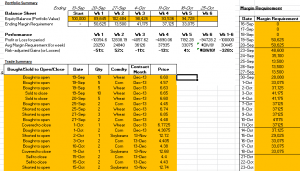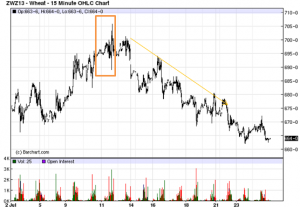This week, I sold corn at the price of 4.4 and 4.43 and shorted soybeans at the price of 12.74. But price of soybeans still tends to rise after my trade. I’ve experienced positive returns in the mid of the week, but what made my portfolio so embarrassing was the immediate increase of wheat price.
My history of wheat trading
In the first two weeks, I bought and sold wheat at a high frequency. But at the point of 6.74, I started to think that the price should drop in the near future because the news impact of lack of supply of Argentina would fade away soon. So I shorted wheat and waited for its drop. In the fourth trading week, I shorted and covered in a short run, which won me a little profit. But it still can’t fix my former mistakes of shorting at such a low level. And now the price is even far away from what I expected it to be. We can never predict accurately for the future, the only way to know why we made a wrong decision is look backward.
The media can never give the answer
The media reported that the demand of import countries and their additional orders for the future wheat supply in US is the reason why there was a surge in wheat price in the end of this week. They also predicted that the price will keep rising. After China’s announcement of purchasing more wheat, the wheat price soared to a high level. And because of the decrease in wheat supply caused by the bad weather conditions in several major export countries, such as US, Australia and Russia, the storage and output have to not only meet the domestic demand, but also satisfy all the demand of import countries like China and Brazil. Both sides have suffered from serious problems in respect of production, it’s easy to understand why the price has been so volatile in recent months.
I searched on the Internet and found that there were several big purchasing orders from China happening in the 2013. (Table 1 & Graphs below) And I also observed the relationship between China’s purchase and tendency of wheat price.
According to the graphs, we can see that although right after the purchase, the wheat market will have a big shock, the tendency of the price will not change in the following trading dates. From the beginning of 2013 to October, the price has been decreasing though with some volatility resulting from factors like big orders from importer and bad weather in major exporters and importers. From my point of view, there will be some fluctuations of price, just like any period in the past, up and down trends will finally bring the price back to the formal level. And hope that I can cover my “high-price” wheat at a proper price sooner or later.
What’s next?
Next week will be the last trading week. Should I say “Hallelujah”?! It seems that I just experienced the process that trade like a gambler- trade like a theoretical economist- trade like a gambler – trade like a theoretical economist. The busy midterm week nearly occupied most of my time, the advantage is that it keeps reminding me of the message that you shouldn’t trade like a gambler.
Please let me enjoy the foggy Vancouver before we start to prepare the next mid-term! Keep finger crossed!!
Vanilla





